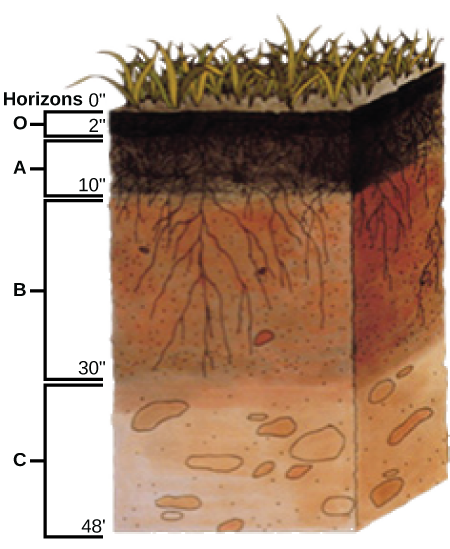31.2C: Physical Properties of Soil
- Page ID
- 13789
\( \newcommand{\vecs}[1]{\overset { \scriptstyle \rightharpoonup} {\mathbf{#1}} } \)
\( \newcommand{\vecd}[1]{\overset{-\!-\!\rightharpoonup}{\vphantom{a}\smash {#1}}} \)
\( \newcommand{\id}{\mathrm{id}}\) \( \newcommand{\Span}{\mathrm{span}}\)
( \newcommand{\kernel}{\mathrm{null}\,}\) \( \newcommand{\range}{\mathrm{range}\,}\)
\( \newcommand{\RealPart}{\mathrm{Re}}\) \( \newcommand{\ImaginaryPart}{\mathrm{Im}}\)
\( \newcommand{\Argument}{\mathrm{Arg}}\) \( \newcommand{\norm}[1]{\| #1 \|}\)
\( \newcommand{\inner}[2]{\langle #1, #2 \rangle}\)
\( \newcommand{\Span}{\mathrm{span}}\)
\( \newcommand{\id}{\mathrm{id}}\)
\( \newcommand{\Span}{\mathrm{span}}\)
\( \newcommand{\kernel}{\mathrm{null}\,}\)
\( \newcommand{\range}{\mathrm{range}\,}\)
\( \newcommand{\RealPart}{\mathrm{Re}}\)
\( \newcommand{\ImaginaryPart}{\mathrm{Im}}\)
\( \newcommand{\Argument}{\mathrm{Arg}}\)
\( \newcommand{\norm}[1]{\| #1 \|}\)
\( \newcommand{\inner}[2]{\langle #1, #2 \rangle}\)
\( \newcommand{\Span}{\mathrm{span}}\) \( \newcommand{\AA}{\unicode[.8,0]{x212B}}\)
\( \newcommand{\vectorA}[1]{\vec{#1}} % arrow\)
\( \newcommand{\vectorAt}[1]{\vec{\text{#1}}} % arrow\)
\( \newcommand{\vectorB}[1]{\overset { \scriptstyle \rightharpoonup} {\mathbf{#1}} } \)
\( \newcommand{\vectorC}[1]{\textbf{#1}} \)
\( \newcommand{\vectorD}[1]{\overrightarrow{#1}} \)
\( \newcommand{\vectorDt}[1]{\overrightarrow{\text{#1}}} \)
\( \newcommand{\vectE}[1]{\overset{-\!-\!\rightharpoonup}{\vphantom{a}\smash{\mathbf {#1}}}} \)
\( \newcommand{\vecs}[1]{\overset { \scriptstyle \rightharpoonup} {\mathbf{#1}} } \)
\( \newcommand{\vecd}[1]{\overset{-\!-\!\rightharpoonup}{\vphantom{a}\smash {#1}}} \)
\(\newcommand{\avec}{\mathbf a}\) \(\newcommand{\bvec}{\mathbf b}\) \(\newcommand{\cvec}{\mathbf c}\) \(\newcommand{\dvec}{\mathbf d}\) \(\newcommand{\dtil}{\widetilde{\mathbf d}}\) \(\newcommand{\evec}{\mathbf e}\) \(\newcommand{\fvec}{\mathbf f}\) \(\newcommand{\nvec}{\mathbf n}\) \(\newcommand{\pvec}{\mathbf p}\) \(\newcommand{\qvec}{\mathbf q}\) \(\newcommand{\svec}{\mathbf s}\) \(\newcommand{\tvec}{\mathbf t}\) \(\newcommand{\uvec}{\mathbf u}\) \(\newcommand{\vvec}{\mathbf v}\) \(\newcommand{\wvec}{\mathbf w}\) \(\newcommand{\xvec}{\mathbf x}\) \(\newcommand{\yvec}{\mathbf y}\) \(\newcommand{\zvec}{\mathbf z}\) \(\newcommand{\rvec}{\mathbf r}\) \(\newcommand{\mvec}{\mathbf m}\) \(\newcommand{\zerovec}{\mathbf 0}\) \(\newcommand{\onevec}{\mathbf 1}\) \(\newcommand{\real}{\mathbb R}\) \(\newcommand{\twovec}[2]{\left[\begin{array}{r}#1 \\ #2 \end{array}\right]}\) \(\newcommand{\ctwovec}[2]{\left[\begin{array}{c}#1 \\ #2 \end{array}\right]}\) \(\newcommand{\threevec}[3]{\left[\begin{array}{r}#1 \\ #2 \\ #3 \end{array}\right]}\) \(\newcommand{\cthreevec}[3]{\left[\begin{array}{c}#1 \\ #2 \\ #3 \end{array}\right]}\) \(\newcommand{\fourvec}[4]{\left[\begin{array}{r}#1 \\ #2 \\ #3 \\ #4 \end{array}\right]}\) \(\newcommand{\cfourvec}[4]{\left[\begin{array}{c}#1 \\ #2 \\ #3 \\ #4 \end{array}\right]}\) \(\newcommand{\fivevec}[5]{\left[\begin{array}{r}#1 \\ #2 \\ #3 \\ #4 \\ #5 \\ \end{array}\right]}\) \(\newcommand{\cfivevec}[5]{\left[\begin{array}{c}#1 \\ #2 \\ #3 \\ #4 \\ #5 \\ \end{array}\right]}\) \(\newcommand{\mattwo}[4]{\left[\begin{array}{rr}#1 \amp #2 \\ #3 \amp #4 \\ \end{array}\right]}\) \(\newcommand{\laspan}[1]{\text{Span}\{#1\}}\) \(\newcommand{\bcal}{\cal B}\) \(\newcommand{\ccal}{\cal C}\) \(\newcommand{\scal}{\cal S}\) \(\newcommand{\wcal}{\cal W}\) \(\newcommand{\ecal}{\cal E}\) \(\newcommand{\coords}[2]{\left\{#1\right\}_{#2}}\) \(\newcommand{\gray}[1]{\color{gray}{#1}}\) \(\newcommand{\lgray}[1]{\color{lightgray}{#1}}\) \(\newcommand{\rank}{\operatorname{rank}}\) \(\newcommand{\row}{\text{Row}}\) \(\newcommand{\col}{\text{Col}}\) \(\renewcommand{\row}{\text{Row}}\) \(\newcommand{\nul}{\text{Nul}}\) \(\newcommand{\var}{\text{Var}}\) \(\newcommand{\corr}{\text{corr}}\) \(\newcommand{\len}[1]{\left|#1\right|}\) \(\newcommand{\bbar}{\overline{\bvec}}\) \(\newcommand{\bhat}{\widehat{\bvec}}\) \(\newcommand{\bperp}{\bvec^\perp}\) \(\newcommand{\xhat}{\widehat{\xvec}}\) \(\newcommand{\vhat}{\widehat{\vvec}}\) \(\newcommand{\uhat}{\widehat{\uvec}}\) \(\newcommand{\what}{\widehat{\wvec}}\) \(\newcommand{\Sighat}{\widehat{\Sigma}}\) \(\newcommand{\lt}{<}\) \(\newcommand{\gt}{>}\) \(\newcommand{\amp}{&}\) \(\definecolor{fillinmathshade}{gray}{0.9}\)- Describe the physical properties or profile of soil
Physical Properties of the Soil
Soils are named and classified based on their horizons. The soil profile has four distinct layers:

- The O horizon has freshly-decomposing organic matter, humus, at its surface, with decomposed vegetation at its base. Humus enriches the soil with nutrients, enhancing soil moisture retention. Topsoil, the top layer of soil, is usually two to three inches deep, but this depth can vary considerably. For instance, river deltas, such as the Mississippi River delta, have deep layers of topsoil. Topsoil is rich in organic material. Microbial processes occur there; it is responsible for plant production.
- The A horizon consists of a mixture of organic material with inorganic products of weathering; it is the beginning of true mineral soil. This horizon is typically darkly colored because of the presence of organic matter. In this area, rainwater percolates through the soil and carries materials from the surface.
- The B horizon, or subsoil, is an accumulation of mostly fine material that has moved downward, resulting in a dense layer in the soil. In some soils, the B horizon contains nodules or a layer of calcium carbonate.
- The C horizon, or soil base, includes the parent material, plus the organic and inorganic material that is broken down to form soil. The parent material may be either created in its natural place or transported from elsewhere to its present location. Beneath the C horizon lies bedrock.
Some soils may have additional layers, or lack one of these layers. The thickness of the layers is also variable, depending on the factors that influence soil formation. In general, immature soils may have O, A, and C horizons, whereas mature soils may display all of these, plus additional layers.

Key Points
- The O horizon, or topsoil, is made of decaying organisms and plant life; it is responsible for plant production.
- The A horizon is of a mixture of organic material and inorganic products of weathering; it is the beginning of true mineral soil.
- The B horizon, or subsoil, is a dense layer of mostly fine material that has been pushed down from the topsoil.
- The C horizon, or soil base, is located just above bedrock and is made of parent, organic, and inorganic material.
Key Terms
- topsoil: top layer of soil containing humus at its surface and decomposing vegetation at its base; the most fertile soil
- subsoil: dense layer of soil containing fine material that has moved downward; the layer of earth that is below the topsoil
Contributions and Attributions
- OpenStax College, Biology. October 17, 2013. Provided by: OpenStax CNX. Located at: http://cnx.org/content/m44715/latest...ol11448/latest. License: CC BY: Attribution
- OpenStax College, Biology. November 21, 2013. Provided by: OpenStax CNX. Located at: http://cnx.org/content/m44715/latest...ol11448/latest. License: CC BY: Attribution
- humus. Provided by: Wiktionary. Located at: en.wiktionary.org/wiki/humus. License: CC BY-SA: Attribution-ShareAlike
- loam. Provided by: Wiktionary. Located at: en.wiktionary.org/wiki/loam. License: CC BY-SA: Attribution-ShareAlike
- OpenStax College, The Soil. October 17, 2013. Provided by: OpenStax CNX. Located at: http://cnx.org/content/m44715/latest...e_31_02_01.png. License: CC BY: Attribution
- rhizosphere. Provided by: Wiktionary. Located at: en.wiktionary.org/wiki/rhizosphere. License: CC BY-SA: Attribution-ShareAlike
- OpenStax College, Biology. October 17, 2013. Provided by: OpenStax CNX. Located at: http://cnx.org/content/m44715/latest...ol11448/latest. License: CC BY: Attribution
- bedrock. Provided by: Wiktionary. Located at: en.wiktionary.org/wiki/bedrock. License: CC BY-SA: Attribution-ShareAlike
- Boundless. Provided by: Boundless Learning. Located at: www.boundless.com//biology/definition/horizon. License: CC BY-SA: Attribution-ShareAlike
- OpenStax College, The Soil. October 17, 2013. Provided by: OpenStax CNX. Located at: http://cnx.org/content/m44715/latest...e_31_02_01.png. License: CC BY: Attribution
- Soft sediment deformation. Provided by: Wikimedia. Located at: commons.wikimedia.org/wiki/Fi...eformation.JPG. License: CC BY-SA: Attribution-ShareAlike
- OpenStax College, Biology. October 17, 2013. Provided by: OpenStax CNX. Located at: http://cnx.org/content/m44715/latest...ol11448/latest. License: CC BY: Attribution
- topsoil. Provided by: Wiktionary. Located at: en.wiktionary.org/wiki/topsoil. License: CC BY-SA: Attribution-ShareAlike
- subsoil. Provided by: Wiktionary. Located at: en.wiktionary.org/wiki/subsoil. License: CC BY-SA: Attribution-ShareAlike
- OpenStax College, The Soil. October 17, 2013. Provided by: OpenStax CNX. Located at: http://cnx.org/content/m44715/latest...e_31_02_01.png. License: CC BY: Attribution
- Soft sediment deformation. Provided by: Wikimedia. Located at: commons.wikimedia.org/wiki/Fi...eformation.JPG. License: CC BY-SA: Attribution-ShareAlike
- OpenStax College, The Soil. October 17, 2013. Provided by: OpenStax CNX. Located at: http://cnx.org/content/m44715/latest...e_31_02_02.png. License: CC BY: Attribution
- OpenStax College, The Soil. October 17, 2013. Provided by: OpenStax CNX. Located at: http://cnx.org/content/m44715/latest...e_31_02_03.jpg. License: CC BY: Attribution


